How to eat okra?
Okra recipes: a novel vegetable with many ways to eat it
Okra is a relatively recent vegetable, boasting a high nutritional value and a crisp texture. While dried okra is commonly available, fresh okra actually has more nutrients and is easy to prepare. Want to know how to make delicious okra and how to prepare it? Here are a few recipes for okra.
Fried Okra with Pork Slices
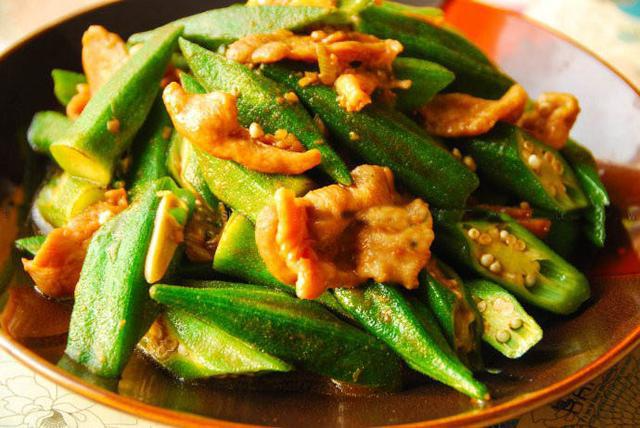
Material
50 grams of clean meat slices, 10 okra.
practice
1. Wash and slice the okra and set aside.
2. Add appropriate amount of cooking oil into the pot and turn on medium heat.
3. Heat the pan, add the meat slices and stir-fry. After the meat slices are fragrant, add the okra and continue stir-frying.
4. Add appropriate amount of salt and rice wine and continue stir-frying.
5. When the vegetables are cooked, add appropriate amount of MSG and pepper and mix well.
Scallion Okra
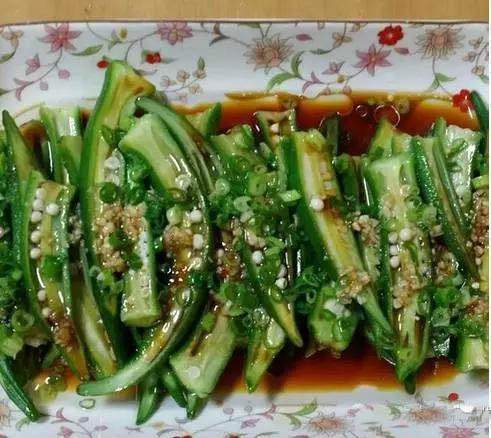
Material
20 grams of scallion segments, 350 grams of okra, and 8 grams of light soy sauce.
practice
1. Wash the okra, blanch it in boiling water, and remove it.
2. Rinse the okra in cold water, remove and cut into sections.
3. Wash and cut the green onions into small pieces and set aside.
4. Place the okra segments on a plate, sprinkle with chopped green onions, pour in light soy sauce and mix well.
Okra fried tomatoes
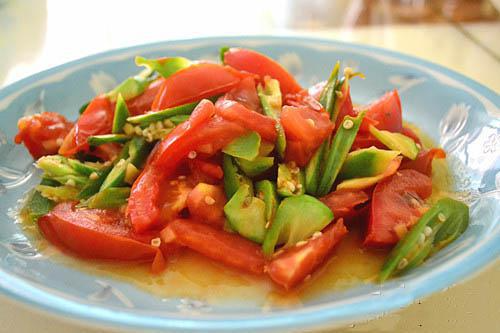
Material
6 okra and 1 tomato.
practice
1. Wash and slice okra and tomatoes.
2. Add an appropriate amount of cooking oil into the pot and turn on medium heat.
3. Heat the pan and pour in tomatoes, stir-fry until the tomato juice comes out, then pour in okra and stir-fry.
4. Add appropriate amount of salt and rice wine and continue stir-frying.
5. After the dish is cooked, add an appropriate amount of MSG and mix well.
Sautéed Okra with Mushrooms
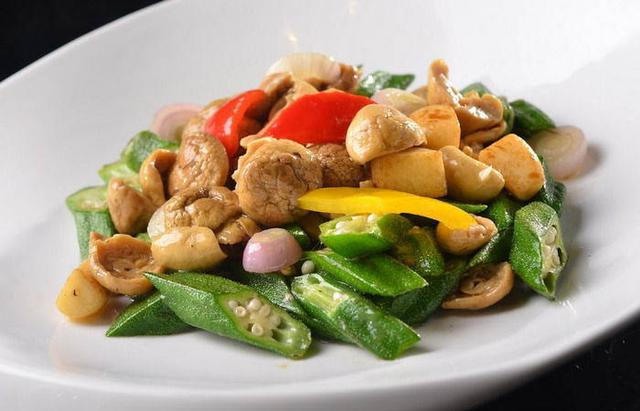
Material
Okra, mushroom, minced ginger, minced garlic, cornstarch, chicken stock, white pepper powder.
practice
1. Remove the head and tail of okra, cut into sections, and halve the mushrooms.
2. Heat oil in a pan, add minced ginger and garlic, add okra and mushrooms after they are half burnt, stir briefly, add salt, stir evenly, add thickening sauce (corn starch, chicken essence, white pepper powder), and serve.
Garlic Okra

Material
120 grams of okra, 4 cloves of garlic, 1/2 chili pepper, 1/2 teaspoon of sugar, 1 teaspoon of sesame oil, 2 tablespoons of soy sauce paste.
practice
1. Wash the okra, put it into boiling water and cook for about 2 minutes, remove the okra, drain and remove the stems, and place it on a plate for later use.
2. Chop the garlic and chili into fine pieces, add all the seasonings and mix well to make a sauce.
3. Pour the sauce from step 2 over the okra from step 1.
Okra scrambled eggs

Material
Two fresh eggs and three okras.
practice
1. Wash and slice the okra. Beat the eggs and set aside.
2. Add an appropriate amount of cooking oil into the pot and turn on medium heat.
3. When the pan is hot, pour in the okra slices and stir-fry. Add the beaten eggs and stir-fry.
4. Add appropriate amount of salt, rice wine, MSG and pepper, mix well and cook until the egg is cooked.
Braised Beef with Okra
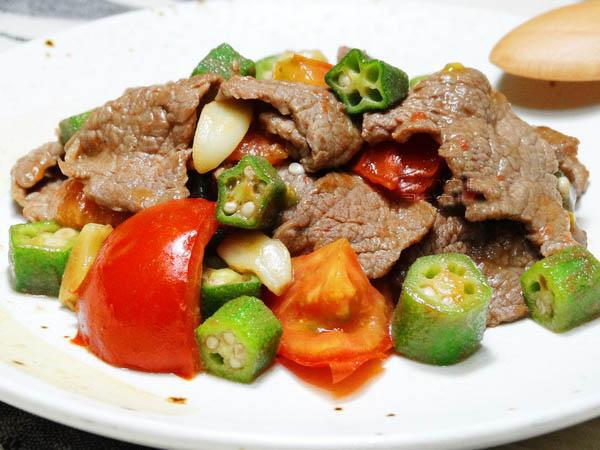
Material
450g beef shank, 200g okra, stems removed, 140g tomatoes, diced, 100g onion, diced, 1 1/2 tsp cornstarch, 2 tbsp vegetable oil, 1 tbsp wine, 3 tbsp tomato sauce, 2 tbsp soy sauce, 1/2 tsp sugar, 1/2 tsp salt.
practice
1. Blanch the beef shank in boiling water for 2 minutes, remove and cut against the grain into 2 cm thick slices.
2. Take a small bowl, put cornstarch and 2 tablespoons of water into it and mix it into cornstarch water.
3. Heat oil in a wok over high heat. Add onion and sauté until fragrant. Add beef and wine and stir-fry briefly. Then, add tomato sauce, tomatoes, 480ml of water, soy sauce, sugar, and salt. Bring to a boil, then reduce heat and simmer for about 1 hour, until beef is cooked through. Add okra and cook until done. Thicken with tartar sauce and serve.
Conclusion: The above is the content of the comprehensive recipe for okra. Okra is now recognized as a nutritious food. Many people like to eat it. Basically, they eat it pickled or fresh okra with sauce. This article introduces several home-cooked methods. Don't miss it.
How to eat okra? Complete recipes for okra
Aliases
Kidney-tonifying vegetables, okra, red pepper, coffee sunflower
How to eat okra? Okra is a uniquely flavored, tender, smooth, and highly nutritious ingredient. Known as "green ginseng" in Japan and South Korea, okra can be eaten in a variety of ways, from stir-frying to serving cold. Below, I'll share three simple and delicious ways to cook okra.
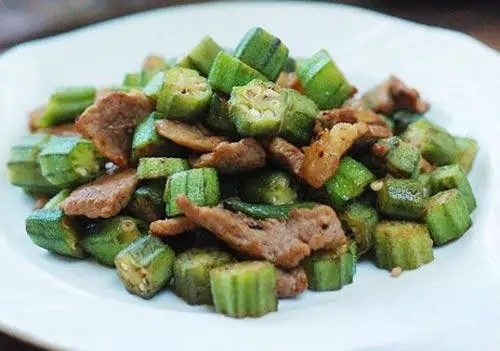
Okra recipe: Okra fried meat
[Ingredients] 200g okra, 100g pork, cooking wine, soy sauce, cooking oil, and salt as appropriate
【practice】
1. Wash the okra and blanch it for 2 minutes.
2. Cut the blanched okra into sections and wash and slice the pork.
3. Heat the oil in the pan, pour in the pork slices, add cooking wine and fry until the surface changes color
3. Heat the oil in the wok again and add the chopped okra and stir-fry.
4. Add the fried pork and season with a little soy sauce and salt.
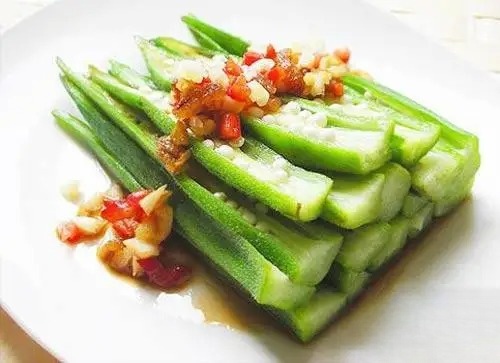
Okra recipe: Okra salad
[Ingredients] 10 okra, 3 red chili peppers, garlic, olive oil, chicken essence, and salt to taste
【practice】
1. Wash the okra, cut it in half, blanch it in boiling water for a while (add a little salt and oil), and then remove it from the water and drain it when it turns emerald green.
2. Peel and chop the garlic and chili pepper
3. Take a plate, put the blanched okra in it, add minced garlic, chili pepper, salt, chicken essence and mix well, and finally drizzle a little olive oil.
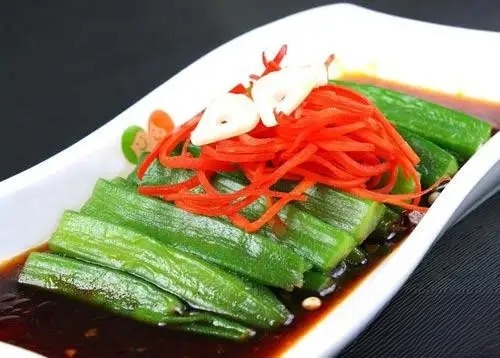
Okra recipe: Blanched okra
【Ingredients】Okra, soy sauce, pepper, red bell pepper, fish sauce, sesame oil, sugar, chicken powder
【practice】
1. Wash the okra, remove the head, cut it in half, put it into boiling water and stir-fry it over high heat for 2 minutes, then pour it out and put it on a plate for later use.
2. Mix chicken powder, sugar, fish sauce, pepper, sesame oil and soy sauce into a sauce and pour it over the okra.
3. Cut the red pepper into strips and sprinkle it on the okra
Okra stir-fried with meat, okra salad, and blanched okra—these three delicious recipes are all simple, nutritious, and healthy. How do you eat okra? Try these three methods.
Health vegetables cannot replace medicines
Source: Southeast Business Daily
On February 5, Ms. Zhou went out for dinner with her friends. A plate of white grass roots on the table kept everyone guessing for a long time. The waiter introduced that it was a cold-mixed Houttuynia cordata with the function of clearing heat and detoxifying.
Vegetables with health benefits are increasingly appearing on people's tables. According to the Vegetable Research Institute of the Municipal Academy of Agricultural Sciences, several health-promoting vegetables have been successfully cultivated and promoted in recent years. These include okra, gypsophila purpurogena (women's vegetable), broccoli, and leafy sweet potatoes, all of which are now cultivated on a small scale and marketed in small quantities. Here, experts introduce a few of these so you won't miss them in restaurants.

Houttuynia cordata: a medicinal plant
Efficacy: clearing away heat and detoxifying, discharging pus and eliminating carbuncle, diuresis and relieving stranguria
"Houttuynia cordata has a strong fishy smell when its stems and leaves are crushed, hence the name. This grass is a medicinal plant." Li Linzhang, a senior agronomist at the Vegetable Research Institute of Ningbo Academy of Agricultural Sciences, introduced that Houttuynia cordata is a common wild vegetable and its cultivation scale is constantly expanding in Fujian, Yunnan, Sichuan, Guizhou, Guangdong and other places.
People who don't like the strong smell of Houttuynia cordata stay away from it, but because of its health benefits of clearing heat and detoxifying, draining pus and eliminating carbuncles, and promoting diuresis and relieving stranguria, it is very popular in the southwest region. Cold Houttuynia cordata is a classic appetizer, which can now be often found in some restaurants in Ningbo and is also sold in large supermarkets.

Purple-backed geranium: suitable for postpartum women
Efficacy: promoting blood circulation and stopping bleeding, detoxifying and reducing swelling
Purple-backed geranium, also known as Guanyin vegetable and blood-tonifying vegetable, primarily grows in southern China and has now been successfully introduced in Ningbo. Li Linzhang explains that the distinctive feature of purple-backed geranium is its oily green leaves on the front and purple-red on the back. It is rich in nutrients, including iron, which contributes to hematopoiesis, flavonoids, and manganese, an enzyme. It has the effects of promoting blood circulation, stopping bleeding, and detoxifying and reducing swelling. "Each 100 grams of purple-backed geranium contains 20.97 mg of iron. Therefore, purple-backed geranium is often used in southern China as a blood-tonifying remedy and is suitable for postpartum women, hence its nickname, 'woman's vegetable.'"
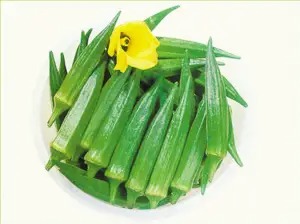
Okra: Known as "men's dish"
Effects: Prevent constipation, protect stomach and liver, fight fatigue, nourish kidney and strengthen yang
Okra is currently grown in many bases in Ningbo, including Yinzhou, Siming Mountain, Zhenhai, Ninghai, etc.
"Okra, also known as lady's fingers and a kidney-tonifying vegetable, is native to tropical Africa. The pods are primarily eaten, and they have a unique aroma and a mellow texture." Li Linzhang explained that okra contains special sticky substances such as pectin and glycoproteins, which promote gastrointestinal motility, prevent constipation, protect the stomach and liver, and are particularly effective in combating fatigue and tonifying the kidneys and enhancing male sexual function. Therefore, okra is known as a "men's vegetable." In the United States, okra is called "plant Viagra" and in Japan, "green ginseng." It is a highly nutritious health vegetable.
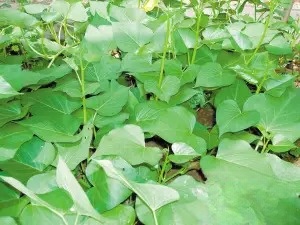
Leaf sweet potato: only eat the leaves and not the roots
Effect: Lubricates the intestines and promotes bowel movements
Ordinary sweet potatoes are eaten as underground tubers. The Vegetable Research Institute of Ningbo Academy of Agricultural Sciences has successfully introduced a kind of sweet potato that is eaten specifically as leaves. The sweet potatoes grown are very small, but the leaves are particularly delicious.
"Taiwanese sweet potato leaves, also known as leafy sweet potatoes, are a variety bred from Taiwan specifically for their edible tender stems and leaves," Li Linzhang explained. Leafy sweet potato leaves are nutritious, rich in protein, crude fiber, amino acids, and vitamin C, and have health benefits such as laxative and bowel-moistening properties. Sweet potato leaves taste just like any other vegetable, and are delicious when stir-fried with minced garlic or with canned dace.

Rich vegetable: unique effects and delicious taste
Efficacy: Lowering blood pressure and blood lipids, inhibiting diabetes, sterilizing and purifying the air
Pleurotus ostreatus is native to South Africa and is also known as fairy vegetable. It is a health vegetable whose main food is the tender stems and leaves.
"The research results of medical experts at home and abroad show that: Chinese pear is a magical health vegetable. Its stems and leaves contain a large amount of nutrients such as alginate, mannitol, vitamin B, sulfur, potassium and various amino acids. Therefore, it has a strong effect of lowering blood pressure, lowering blood lipids and inhibiting diabetes. It can also kill bacteria and purify the air when placed indoors." Li Linzhang introduced that Chinese pear can be fried and eaten or made into soup. When stir-frying, it should be blanched in boiling water and then minced garlic should be added before stir-frying. It can also be served cold, and the taste is refreshing and delicious.
■Reminder
Health vegetables
Cannot replace medicine
"Health-care vegetables do have certain health-care effects, and some even have certain medicinal effects. Regular consumption can cure diseases and improve health, but they cannot replace medicines." Wang Yuhong, director of the Vegetable Research Institute of the Ningbo Academy of Agricultural Sciences, introduced that as people pay more attention to health and wellness, health-care vegetables are becoming more and more popular. Since health-care vegetables are more expensive than ordinary vegetables and the awareness of ordinary citizens is not high, the current market for health-care vegetables is mainly sold in some hotels and restaurants. I believe that as people's understanding deepens, they will also be popularized on the tables of more ordinary citizens.
19 Ways to Eat Okra

Nutritional Value of Okra
Okra contains pectin and lactose, which aid digestion, treat gastritis and gastric ulcers, and protect the skin and gastric mucosa. It is considered one of the best health vegetables for humans.
It contains a variety of nutrients, including iron, calcium, and carbohydrates, which can help prevent anemia. The mucin it secretes protects the stomach lining, promotes gastric juice secretion, increases appetite, and improves indigestion. It also contains vitamin A, which is beneficial for retinal health and vision.
For young adults and athletes, okra can relieve fatigue and quickly restore physical strength. The young okra fruit contains a viscous liquid as well as arabinan, galactan, rhamnose, protein, and calcium oxalate. Regular consumption aids digestion, boosts physical strength, protects the liver, and strengthens the stomach and intestines.
Okra contains special medicinal ingredients that strengthen the kidneys and tonify deficiencies, providing a therapeutic aid for organic diseases in men. It is a suitable nutritional and health-promoting vegetable, earning the nickname "plant Viagra."
Okra is also rich in trace elements like zinc and selenium, which can enhance the body's cancer prevention and treatment capabilities. It's also rich in vitamin C and soluble fiber, making it not only healthy for the skin but also whitening and tenderizing.
1. Stir-fried Okra with Bacon Slices
Ingredients: Okra, chili peppers, bacon slices, garlic;
Practice:
1. Slice the okra and chili peppers and cut the bacon slices into several sections;
2. Sauté the bacon slices first and set aside;
3. In a separate pan, add the minced garlic. When it's half-charred, add the okra and chili peppers. Stir-fry briefly, then add a pinch of salt and scallions.
4. Add the bacon slices, toss well, and serve.
Tips: This dish is salty, fresh, and fragrant, with a slight spicy kick.
2. Scallion Okra
Ingredients: 350g okra, 20g scallions, 8g light soy sauce
Practice:
1. Wash the okra, blanch in boiling water, and remove.
2. Rinse the okra in cold water, remove, and cut into sections.
3. Wash and cut the scallions into florets and set aside.
4. Place the okra sections on a plate, sprinkle with chopped scallions, and toss with light soy sauce.
3. Stir-fried Okra with Tomatoes
Ingredients: 6 stalks of okra, 1 tomato
Practice:
1. Wash and slice the okra and tomato, and set aside.
2. Add an appropriate amount of cooking oil to a wok over medium heat.
3. Heat the wok, add the tomatoes, and stir-fry. Once the tomato juices are released, add the okra and stir-fry.
4. Add salt and rice wine as needed and continue stir-frying.
5. Once cooked, add a desired amount of MSG and mix well.
4. Garlic Okra
Ingredients: 120g okra, 4 cloves of garlic, ½ chili pepper, ½ teaspoon sugar, 1 teaspoon sesame oil, 2 tablespoons soy sauce paste;
Practice:
1. Wash the okra and blanch in boiling water for about 2 minutes. Drain and remove the stems. Set aside.
2. Mince the garlic and chili peppers and mix well with all the seasonings to make a sauce.
3. Pour the sauce from step 2 over the okra in step 1.
5. Okra Scrambled Eggs
Ingredients: 5 stalks of okra, 2 eggs, chopped green onions as needed;
Practice:
1. Wash and shred the okra. Peel and beat the eggs, then set aside.
2. Heat the oil in a wok over medium heat. Add the shredded okra and stir-fry. Add salt and continue to stir-fry.
3. Add the eggs and continue frying. Then add appropriate amounts of chopped green onions, MSG, and rice wine. Serve when cooked.
6. Braised Beef with Okra
Both tomatoes and tomato sauce are rich in lycopene. Cooking with oil enhances lycopene absorption, helping to maximize its antioxidant and anti-aging properties.
Ingredients:
450g beef shank, 200g okra, stems removed, 140g tomatoes, diced, 100g onions, diced, 1 1/2 teaspoons cornstarch, 2 tablespoons vegetable oil, 1 tablespoon rice wine, 3 tablespoons tomato sauce, 2 tablespoons soy sauce, 1/2 teaspoon sugar, 1/2 teaspoon salt.
Practice:
1. Blanch the beef shank in boiling water for 2 minutes. Remove and slice against the grain into 2 cm thick slices.
2. In a small bowl, combine cornstarch and 2 tablespoons water to create a cornstarch water mixture.
3. Heat oil in a wok over high heat. Add onion and sauté until fragrant. Add beef and wine and stir-fry briefly. Then, add tomato sauce, tomatoes, 480ml of water, soy sauce, sugar, and salt. Bring to a boil, then reduce heat and simmer for about 1 hour, until beef is cooked through. Add okra and cook until done. Thicken with tartar sauce and serve.
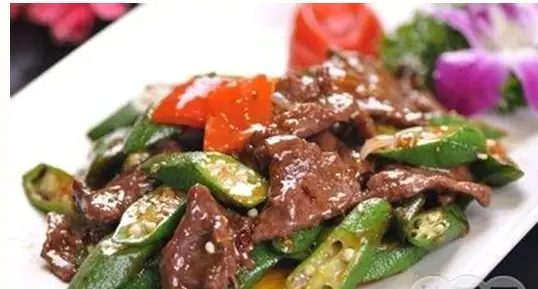
7. Boiled Okra
Ingredients: Okra, light soy sauce;
Practice:
1. Remove the roots of the okra;
2. Bring water to a boil in a pot, add the okra, and cook until done. Remove from the heat;
3. Drizzle with light soy sauce and serve. Simple, delicious, and original.

8. Lotus Root and Okra
Ingredients: 2 lotus roots (with nine holes), 2 okra, half a carrot, sunflower oil, salt, light soy sauce, and chicken bouillon to taste.
Practice:
1. Dice the lotus root and carrots.
2. Slice the okra.
3. Heat a wok and add a suitable amount of oil. First, add the carrots and stir-fry. Then, add the diced lotus root and stir-fry together.
4. Add a pinch of salt and continue stir-frying. Then add the okra.
5. Add a little water and light soy sauce for color.
6. Sprinkle with some chicken bouillon before serving.

9. Okra and Chicken Salad
Ingredients: Okra, chicken, cherry tomatoes, lemon, black pepper, green mustard, salt, olive oil.
Instructions:
1. Cut the okra in half and blanch in boiling water for 5 minutes. Remove from heat. Sauté the chicken in hot oil until cooked through and set aside. Cut the cherry tomatoes in half and set aside.
2. Combine all ingredients in a container. Add salt, black pepper, olive oil, green mustard, and a squeeze of lemon juice. Mix well.

10. Okra Apple Juice
Apples and okra (also known as lady's fingers or lady's fingers) both contain pectin, which can regulate the digestive system and is effective in treating mild diarrhea or constipation. Weight loss advocates eating more apples, not only because the pectin absorbs water and expands to provide a feeling of fullness, but also because it helps reduce the risk of gallstones caused by excessive bile concentration due to insufficient food intake.
Ingredients: 1 apple, 3 okra stalks, 2 celery stalks, 120cc ice water, honey to taste.
Instructions:
1. Wash the okra, remove the stems, and finely dice. Wash the apples and celery, remove the roots and stems, and finely dice.
2. Place all fruits and vegetables in a blender and add ice water.
3. Blend twice on the instant blender, then on the slow setting for 3 minutes until the ingredients are finely ground and smooth.
4. Add honey to taste.

11. Stir-fried Asparagus, Okra, and Onions
This is a very easy dish to make. Mince the garlic in a pan, add the asparagus and okra, and stir-fry briefly. When they are about 70% done, add salt and stir well. You can also add some seafood sauce, sweet bean sauce, etc. Add the onion rings, stir briefly, and serve. Adding the onion rings later prevents them from being overcooked, so they still taste good. This simple dish is healthy and beneficial.
Ingredients: Asparagus, okra, minced garlic, salt, seafood sauce, sweet bean sauce.
Practice:
1. This is a very easy dish to make. Mince the garlic in a pan, add the asparagus and okra, and stir-fry briefly.
2. When they are about 70% done, add salt and stir well. You can also add some seafood sauce, sweet bean sauce, etc. Add the onion rings, stir briefly, and serve.
Tip:
Adding the onion rings later prevents them from being overcooked, so they still taste good.
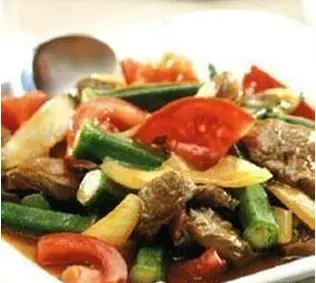
12. Okra Nigiri Sushi
Ingredients: 1/2 tsp mayonnaise, 1/2 tsp mustard, 1 okra, sushi rice to taste;
Practice:
1. Whisk mayonnaise and mustard until combined and set aside;
2. Remove the stems from the okra, trim the edges, and blanch in boiling water until emerald green. Soak in ice water, remove, and cut in half;
3. Take a suitable amount of sushi rice, shape it into an oval, place a piece of okra from step 2 on top, and gently press to shape;
4. Place the ingredients from step 1 into a homemade rolling paper roll and cut a small slit to create a beautiful decorative line on the sushi.

13. Sausage and Okra Stir-fry
Ingredients: Okra, sausage, minced garlic
Practice:
1. Cut okra into sections and slice the bacon and sausage.
2. Sauté the sausage and set aside.
3. In a separate pan, add the minced garlic and sauté the okra until about 70% cooked. Add salt and stir-fry. Add the sausage and serve. Done!
14. Okra Stir-fried Rice Noodles
Ingredients: 150g dried rice noodles, 3 okra, 10 shiitake mushrooms, 100g cabbage, chopped green onions as needed.
Practice:
1. Soak the dried rice noodles in cold water for 30 minutes and remove.
2. Wash the okra, soak 10 shiitake mushrooms, and shred 100g cabbage, setting aside.
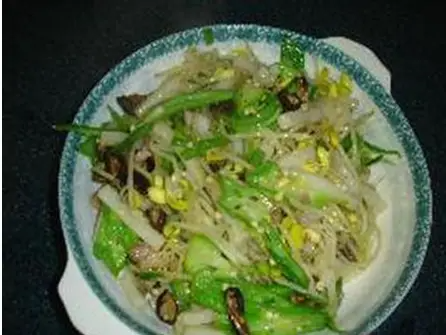
15. Okra Rice Noodle Soup
Ingredients: 3 okra, 50g rice noodles, 50g cooked pork tripe
Practice:
1. Wash and shred the okra. Shred the cooked pork tripe and set aside.
2. Bring an appropriate amount of water to a boil in a pot, then add the rice noodles and bring to a boil.
3. Once the noodles are boiled, add the shredded cooked pork tripe and okra and cook together.
4. Once the noodles are cooked, add appropriate amounts of salt, MSG, pepper, and chopped green onions and mix well.
16. Stir-fried Okra with Pork Slices
Ingredients: 50g sliced pork, 10 okra.
Practice:
1. Wash and slice the okra and set aside.
2. Add an appropriate amount of cooking oil to a pot over medium heat.
3. Once the pot is hot, add the pork slices and stir-fry. Once the pork slices are fragrant, add the okra and continue stir-frying.
4. Add appropriate amounts of salt and rice wine and continue stir-frying.
5. When the vegetables are cooked, add appropriate amount of MSG and pepper and mix well.
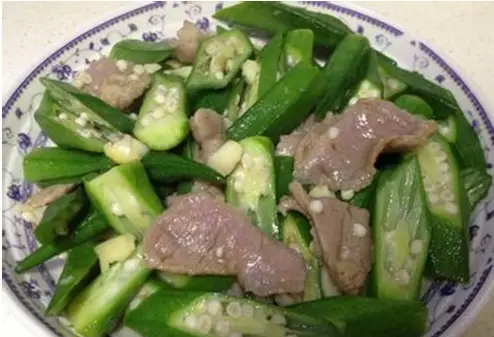
17. Okra, Yunnan Ham, and Bamboo Fungus Stew
Ingredients: 5 fresh okra, 20g dried bamboo fungus, 20g Yunnan Ham, salt, 500g chicken broth;
Practice:
1. Wash and cut the ingredients;
2. Add chicken broth and water to a pot, bring the ham to a boil, and remove the foam. Simmer for 30 minutes, then add the bamboo fungus and cook for 10 minutes. Add the okra and cook for 3 minutes. Season to taste.
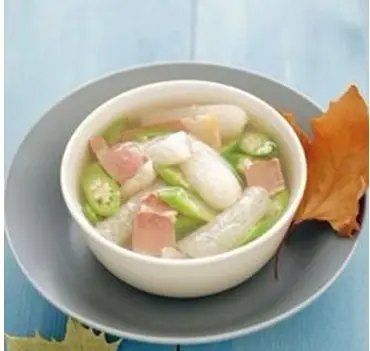
18. Cold Okra Salad
Ingredients: 300g okra, dried bonito flakes to taste, 1-2 teaspoons soy sauce, 2-3 teaspoons oyster sauce, 1 teaspoon sesame oil, 1 teaspoon sugar, and water to taste.
Practice:
1. Wash the okra and boil it in boiling water for 3-5 minutes until cooked through. Drain and rinse briefly with cold water, then arrange on a plate.
2. Add a little water to the soy sauce and microwave for 5-10 seconds until slightly warm. Add sugar and stir until dissolved. Add oyster sauce and sesame oil, mix well, and pour over the okra.
3. Sprinkle with a handful of dried bonito flakes, mix well, and serve.
Tips:
1. Turn the okra over occasionally while cooking; the cooked okra will be darker in color than when raw. Be careful not to overcook it; it will release slime and become mushy. Whether or not to eat the okra stems is entirely up to personal preference.
2. Dried bonito flakes (also known as dried bonitos) are sold near the Japanese seasonings in Chinese supermarkets. If you don't have them, feel free to omit them; they'll still be delicious!
19. Tomato Vegetable Soup
Ingredients: 400g red tomatoes, 15g dried white fungus, 3 okra, 400cc water, 200cc vegetable broth, 10cc mirin.
Practice
1. Soak the white fungus in water until it fully expands and returns to its original shape. Wash, remove the hard stems, and finely chop.
2. Wash the okra and blanch in boiling water until it turns bright green. Remove and soak in cold water. Let cool, drain, and cut diagonally into approximately 0.3cm slices.
3. Wash the red tomatoes, lightly score them in a cross-shaped pattern, and blanch in boiling water until the skin opens. Remove, let cool slightly, peel, and cut into moon-shaped pieces.
4. Put the red tomato pieces processed in step 3 into the soup pot together with water and vegetable broth. Bring to a boil over high heat, then reduce to medium-low heat and continue cooking until the red tomatoes are fully cooked and soft. Add the chopped white fungus from step 1 and continue cooking for about 5 minutes. Season with mirin. Add the okra slices from step 2 before turning off the heat.

Complete Guide to Eating Okra
Other names: okra, lady's finger, coffee sunflower, hairy eggplant
Calories: 37 kcal (100 g edible portion)
Categories: Vegetables, Fungi, Algae, Food and Medicine, Vegetables
Suitable for the general population. Suitable for gastritis, cancer, gastric ulcer, anemia, indigestion, especially for young adults, athletes, skin care women and men.
1. Steps to cook scallion oil okra
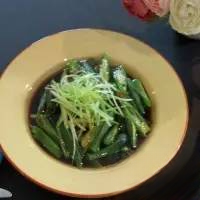
Wash the okra, blanch it in boiling water, quickly remove it, rinse it with cold water, drain the water and place it on a plate; wash the green onions, cut them into shreds and place them on the okra; pour a small amount of light soy sauce on the plate; heat the salad oil, pour it on the green onion shreds, and stir it when eating.
2. Okra scrambled eggs.
1. Wash the okra first.
2. Boil a little water, add okra and cook for 2 minutes.

3. Remove the okra and cut into small pieces. Beat the eggs. Heat a pan with a little oil. Add the eggs and stir-fry. Add the chopped okra and stir-fry a few times. Add salt and remove from heat.
3. Steps to prepare healthy okra
1. Wash the okra and cut it into several strips from the middle. Boil water in a pot and put the okra in. Cook until it becomes slightly soft and then remove from the pot immediately.
2. If you like to eat it cold, you can rinse it with cold water, then add appropriate amount of soy sauce and vinegar and refrigerate it. Just mix it slightly when you want to eat it.
4. Steps for steaming okra
1. Wash the okra, put it in a pot of water and boil for three minutes, then take it out and rinse it.
2. Soak a small amount of vermicelli in boiling water until softened
3. Place vermicelli on the bottom of the plate, remove the top of okra and cut it into pieces and place it on the vermicelli. Place the chopped garlic on top. Pour three tablespoons of light soy sauce on the dish. Heat the oil and steam it for ten minutes.
5. Okra with oyster sauce
1. Heat the oil until hot, add minced garlic and red pepper (you can crush the red pepper to make it more fragrant)
2. When the aroma comes out, add the chopped okra and stir-fry

3. Add appropriate amount of oyster sauce and water, and add a little salt after the color is applied
6. Steps for blanching okra
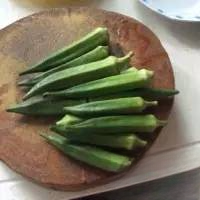
1. Wash okra and set aside.
2. Put water in a pot, add salt, and blanch the okra for 2 minutes after boiling.
3. Rinse with cold water and serve.
4. Place a few shredded red bell peppers on top for color and dipping sauce (use whatever flavor you like) on the side. Chill the okra in the refrigerator for a better taste. (Finished product image.)
7. Steps for cooking okra
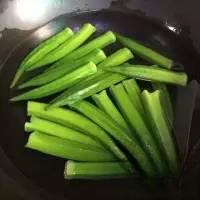
1. Don't choose okra that is too big or too old, as it will not taste good. Wash it, remove the stems, and boil it in boiling water for a while. Then cook it over medium heat. You can cover the pot and cook it until the okra changes color or can be easily pierced with chopsticks. If it doesn't taste good, just taste it directly. It will not taste good if it is not cooked or too soft.
2. I use Yipinxian soy sauce for dipping sauce. It is already seasoned and you don’t need to add anything else. If you don’t have Yipinxian, you can use soy sauce, sugar and a little warm water to season it. If you like sour, add a little vinegar.
3. It’s easy to do, put it on the plate, and it tastes great~
8. Steps for making fried okra with sausage
1. Wash the okra as the main ingredient. I used Pengcheng's large sausage, which is sweet and delicious. This sausage is very versatile and can be eaten with fried rice, fried snow peas, and fried bamboo shoots. They are all delicious.
2. This is the local okra I bought later. It is very fresh and a bit more expensive.
3. Cut okra into small pieces and slice sausage
4. Heat oil in a pan, add onion slices and stir-fry

5. Add okra and sausage and stir-fry

6. Pour in some light soy sauce. Use light soy sauce instead of soy sauce, otherwise the color of the finished product will not look good and the okra will turn black.

7. Add half a spoonful of salt

8. Half a spoonful of chicken powder

9. Pour a few drops of Maggi sauce, stir fry for a while, and serve.

10. Steps for stir-fried okra with shredded pork
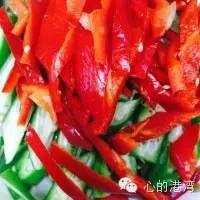
1. Chop okra and red pepper
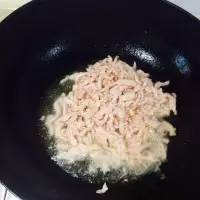
2. Add a little oil to the pan and fry the shredded pork
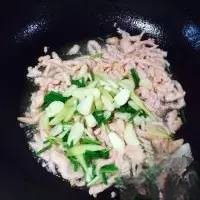
3. A little onion, ginger and garlic
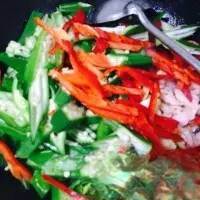
4. Put okra and red pepper strips into the pot, add chicken essence, salt, a little thirteen spices, and a little seafood soy sauce
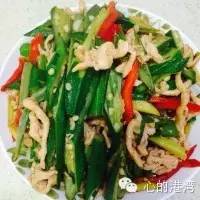
5. It’s out of the pan and delicious!
11. Steps to cook okra with garlic sauce
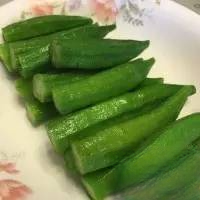
1. Boil the okra for 3 minutes without cutting the roots, then remove the roots and place on a plate.

2. Sauté half a bowl of minced garlic with olive oil, then add half a bowl of soy sauce, stir-fry and serve as the sauce.
12. [Salt-roasted okra]
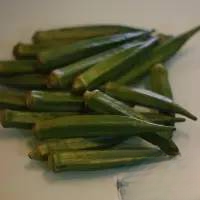
1. Fresh okra
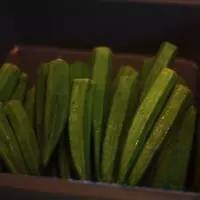
2. Rinse the okra and cut off the stem.

3. Bring the water to a boil and blanch the okra for 30 seconds. Remove from the water and drain.

4. Place the drained okra on a baking sheet, add olive oil and toss well.
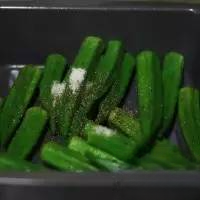
5. Add salt and black pepper and mix well.

6. Place in the lower middle layer of a preheated oven at 180°C and bake for 10 minutes.

7. Joyoung oven at work. Joyoung oven is great for making oven dishes.
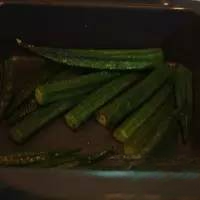
8. Roasted okra.

9. The back of the Joyoung oven exhausts quickly.
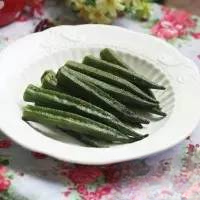
10. Original salt-roasted okra.
13. Steps for Stir-fried Okra with Fungus

1. Chop the onion and garlic, and cut the okra into sections.
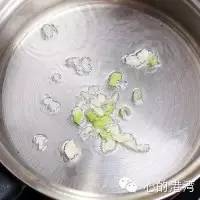
2. Heat oil in a pan and stir-fry onions and garlic.
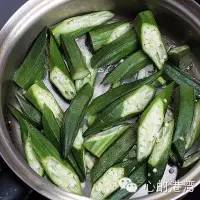
3. Add okra
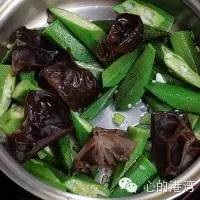
4. When the okra turns green, add the fungus
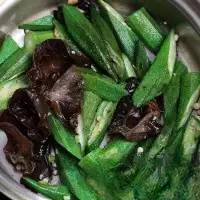
5. Pour in soy sauce and stir-fry over medium heat for 1-2 minutes.
14. Steps to make okra with sesame sauce
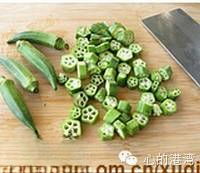
1. Wash the okra, remove the stems, and cut in half or into small pieces;
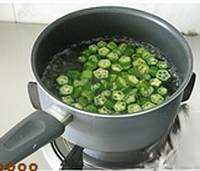
2. Bring water to a boil in a pot, add 1 teaspoon of salt and a few drops of oil, add okra and cook for 7-8 minutes;
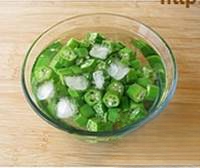
3. Remove the okra and soak in ice water. Let it cool and then drain.
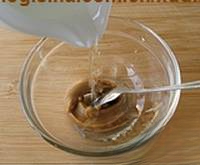
4. Put sesame paste in a bowl, add cold water little by little to dilute it, then add salt, sugar, soy sauce, vinegar, and sesame oil to make sesame sauce;
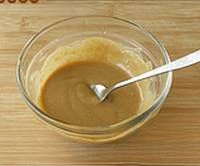
5. Pour the mixture over the okra and mix well before serving.
15. Steps to make Lao Gan Ma spicy okra
1. Wash and remove the roots of okra, mince garlic, add Lao Gan Ma sauce, light soy sauce, and a little salt

2. Okra contains calcium oxalate, so it needs to be blanched in boiling water with a little salt.
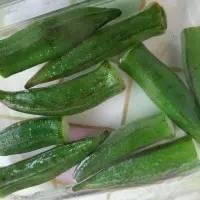
3. Rinse with cold water

4. After draining, put it into a fresh-keeping bag and refrigerate
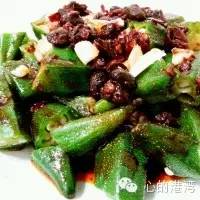
5. Cut the okra into sections, sprinkle with minced garlic, heat the sauce, add a little olive oil and pour over the minced garlic.
16. Steps for making okra and shredded radish soup
1. Soak the vermicelli and dried shrimp in clean water in advance.
2. Peel and shred the radish.
Soak the shredded radish in light salt water.
3. Wash the okra, then cut into small stars and set aside.
4. Pour oil into the wok, fry the shredded ginger until fragrant, then add the shredded radish and stir-fry.
Add the dried shrimps and okra and stir-fry briefly.
5. Add water and bring to a boil. Add vermicelli after the water boils.
Cook briefly, then drizzle with a thin starch slurry. Season with salt and drizzle with sesame oil.
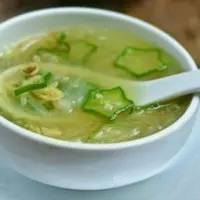
6. Remove from the pan.
Okra cooking methods and eating taboos
Okra's long, narrow fruit resembles a goat's horn, earning it the name "lady's finger." Its tapering tail resembles a woman's delicate finger, earning it the euphemistic name "Lady's Finger" from the British. Okra can be eaten cold, stir-fried, deep-fried, stewed, or used in salads and soups. Its nutritional value is particularly high, and with the increasing emphasis on health and natural eating, okra has become an increasingly popular vegetable.

Taboos on eating okra
Okra is a vegetable with a cold nature and flavor. People with weak gastrointestinal function, poor function, and frequent diarrhea should not eat too much.
Okra cooking tips
Okra is a very nutritious vegetable, especially its seeds and gelatin, which have unique health benefits. Therefore, the best way to eat it without losing any nutrients is to cook it whole. If it is too large, at best, cut it in half, crosswise, or into sections. Never slice it or shred it.
Many people cannot tolerate the large amount of mucus inside okra. You can rub it with cornstarch before cooking and then rinse it with cold water to remove the mucus.
Best utensils: Aluminum, stainless steel, or enamelware. Avoid using copper or iron utensils for cooking or serving, as they will quickly discolor the okra. While harmless, this will compromise the flavor and look unattractive.
How to Choose Okra
Okra that is plump and straight in shape is well-grown and of better quality.
The smaller the okra, the more tender it is. A length of 5-10 cm is ideal. Gently squeeze it and it should feel firm but not hard. A plump, bright-colored okra with hairy ridges is good. Dark, dry okra is old.
Avoid choosing okra that has signs of insect infestation, as the inside may be rotten.
Do not choose okra with black spots on the fruit body, as this means the okra was damaged during transportation, its quality was affected, and it is more likely to rot.
How to store okra
Okra respires rapidly at higher temperatures, causing rapid aging, yellowing, and decay. It's best stored at 7°C to 10°C, where it has a shelf life of about 10 days. Avoid exposing okra to ice or ice water, as this will cause it to become soft and mushy, losing its original springy texture.
It's best to eat it the same day you buy it. To preserve it, wrap it in white newspaper, then cover it with a plastic bag or plastic wrap and refrigerate it. It's recommended to consume it within two days, otherwise it will quickly go bad.
Because okra is very easy to be scratched and will turn black quickly after being scratched, it is best to pick it up individually when picking and storing it, and do not squeeze it. It is best to put it in a fresh-keeping bag before putting it in the refrigerator, and try to let it lie flat.
Basic eating methods
Okra can be eaten cold, stir-fried, fried, stewed, and made into salads, soups, etc. Before eating it cold or stir-fried, it must be blanched in boiling water for three to five minutes to remove the astringency.
Recipe Introduction
1. Okra with scallions
Ingredients: 350g okra
Seasoning: 20g green onion, 8g light soy sauce
Preparation method:
1) Wash the okra, blanch it in boiling water, and remove it;
2) Rinse the okra in cold water, remove and cut into sections;
3) Wash and cut the green onions into small pieces;
4) Place the okra segments on a plate, sprinkle with chopped green onions, pour in light soy sauce and mix well.
Cuisine and efficacy: Home cooking recipes, cancer prevention recipes, youth recipes, athlete recipes, gastritis recipes
2. Tofu and Okra
Main ingredients: 300g okra, 1 piece of tofu
Seasoning: 1 tablespoon salt, 1/2 teaspoon vegetarian fresh
Preparation method:
1) Blanch okra, drain and cut into star shapes.
2) Grind the tofu and seasonings in a mortar and pestle until combined. Add to the okra and mix well.
Cuisine and efficacy: Refreshing cold dish
3. Italian Vegetable Salad
Ingredients: Lettuce as needed, onion as needed, 5 black olives, 2 okra, 1 baby corn, cucumber as needed, almond slices as needed, toast as needed, tomato as needed, 3 tablespoons of vinaigrette dressing (egg-free dressing is recommended).
1) Wash and chop the vegetables separately and set aside.
2) Place the lettuce in a transparent bowl, then add the other ingredients one by one, and finally put the black olives and toast. Drizzle with vinaigrette and sprinkle with almond slices.
3) The ingredients in the sauce must be chopped into fine pieces.
How to make okra salad
Okra is the real nemesis of diabetes!
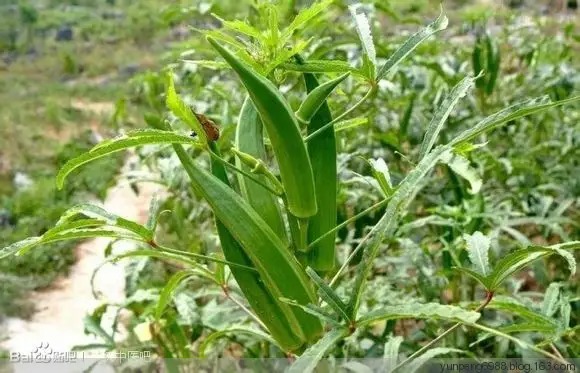
Diabetes killer: Okra
Okra, also known as Bhindi, is known as the plant Viagra and a diabetes nemesis. Last month, I learned about a diabetes treatment on a TV program.
Take two kiwi beans and cut off the ends, then make a small cut along the middle of the long stem. Then put the two kiwi beans in a cup of clean water (at room temperature), cover it and leave it at room temperature overnight.
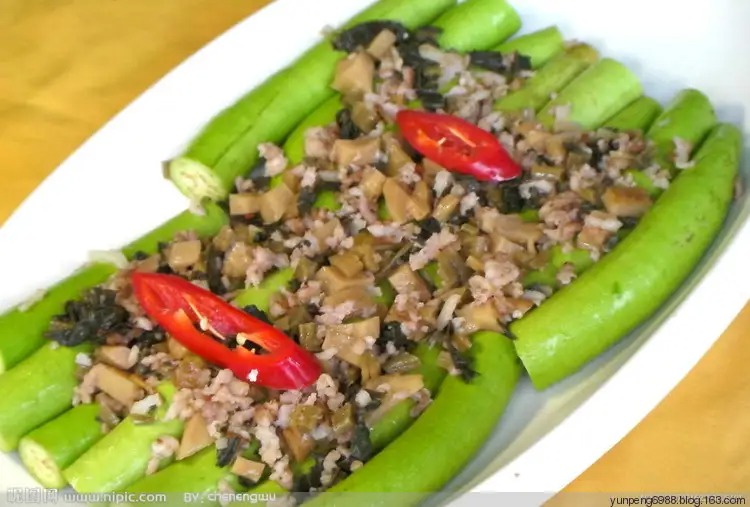
In the morning, before breakfast, remove two yams from the water and drink the water. Do this every day. Within two weeks, you will see amazing results in lowering your blood sugar.
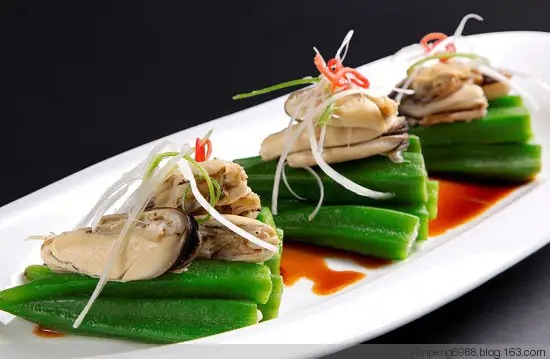
Take hexagonal beans every day
Chop the gram, add it to water and drink it the next morning. Try it, even if it doesn't work for you there's no harm in that, but since most cases are chronic, you'll need to take it for a few months before you see any results.
Related information about okra
The number of people with diabetes seems to be increasing. In addition to traditional Chinese and Western medicine treatments, dietary therapy is also recommended to alleviate symptoms and prevent their progression. Commonly recommended dietary therapies include Chinese yam and okra. Here's some information on okra for your reference: Okra (scientific name: Abelmoschus sculentus) is also known as six-cornered bean, yellow okra, hollyhock, and lady's finger bean.

1. The main functions of okra:
1. Protect gastric mucus
In addition to containing rich nutrients, its mucus can adhere to the gastric mucosa and protect the stomach wall, which is commonly known as "taking care of the stomach."
2. Prevent colorectal cancer
The sticky juice of okra contains water-soluble fiber pectin, galactan, and gum arabic. These three ingredients are all water-soluble dietary fiber. In addition to lowering blood pressure and aiding digestion, they are also helpful in preventing colorectal cancer.
3. It contains more calcium and is easier to absorb than milk
For example, 100 grams of okra contains 80 to 100 mg of calcium, comparable to an equal weight of fresh milk. However, okra's calcium absorption rate is 50 to 60%, which is better than milk. This makes it an excellent source of calcium for vegetarians, growing children, and those who experience diarrhea after drinking milk.

2. Notes:
1. It has a cold nature. People with weak spleen and stomach, prone to diarrhea or loose stools should not eat too much.
Okra is a cold food, so people with yin deficiency should not eat it in excess; for those with poor gastrointestinal function, overeating may cause diarrhea.
Okra is very susceptible to scratches and will quickly turn black after being scratched. When picking or storing, pick it up individually and do not squeeze it. It is best to put it in a fresh-keeping bag before putting it in the refrigerator and try to let it lie flat.
3. The effect of okra on diabetes
Taking okra can relieve the symptoms of diabetes and control blood sugar.
Instructions: Take two jackfruit beans and cut off the ends. Then make a small cut along the middle of the long stem. Place the two beans in a cup of room temperature water, cover, and let sit at room temperature overnight. In the morning, before breakfast, remove the two beans from the water and discard them, then drink the water. Another method is to chop the two beans each evening, add about a bowl of boiling water, and drink the entire amount the next morning. Do this daily for two weeks and you'll see a blood sugar lowering effect. Diabetics should try this. If taking okra causes diarrhea, try taking Chinese yam instead. High blood sugar levels require a combination of both traditional Chinese and Western medicine for stable results.
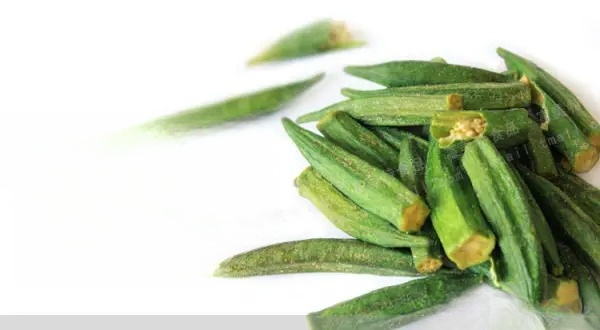
Experts remind that natural compound enzymes can treat diabetes:
Diabetes is a disease caused by impaired insulin secretion or pancreatic inflammation, which reduces insulin secretion and leads to impaired sugar metabolism. As a result, unmetabolized sugar is excreted in the urine and cannot be stored for future use. Therefore, patients must regularly supplement with sugar, but not excessively, as this can worsen the condition. Diabetes itself is not a serious problem. However, the real danger lies in the chronic lack of glucose (monosaccharides) and nutrients caused by impaired sugar and nutrient metabolism, which can lead to the gradual failure of organs such as the liver, kidneys, and heart, leading to death.
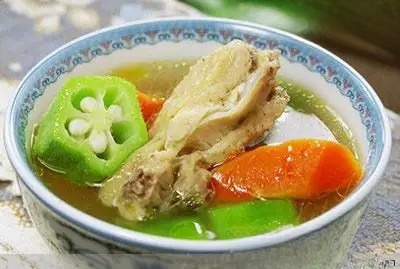
Diabetes, a chronic disease, is one of the top ten causes of death from disease. Especially in today's food-rich society, the chances of a cure for diabetes are slim. Current treatment methods typically involve insulin injections, which only temporarily relieve the patient's pain but fail to cure the disease fundamentally and can worsen the condition. Enzyme therapy, however, can help patients regain their vitality, as enzymes effectively regulate insulin secretion, a fundamental treatment. However, patience is crucial during treatment, and one must persist until a complete cure is achieved. Chronic disease treatment requires time; otherwise, giving up halfway will lead to wasted effort.
Okra is the antidote to diabetes! Reposting once may save a life

Okra, also known as Bhindi, is known as the plant Viagra and a diabetes nemesis. Last month, I learned about a diabetes treatment on a TV program.
Since I am diabetic, I tried it and it worked very well, my blood sugar is now under control. I have actually reduced my medication.
Take two kiwi beans and cut off the ends. Then make a small cut along the middle of the long stem. Then put the two kiwi beans in a cup of clean water (at room temperature), cover and leave at room temperature overnight.
In the morning, before breakfast, remove two yams from the water and drink the water. Do this every day. Within two weeks, you will see amazing results in lowering your blood sugar.
My sister has been cured of her diabetes. She'd been taking insulin for years, but after taking alfalfa every morning for several months, she stopped taking insulin and continued taking alfalfa daily. She chopped the alfalfa every night, added it to water, and drank it the next morning. It's worth giving it a try; even if it doesn't have a significant effect on you, there's no harm in doing so. However, since most cases are chronic, you'll need to continue taking it for several months before you see any results.
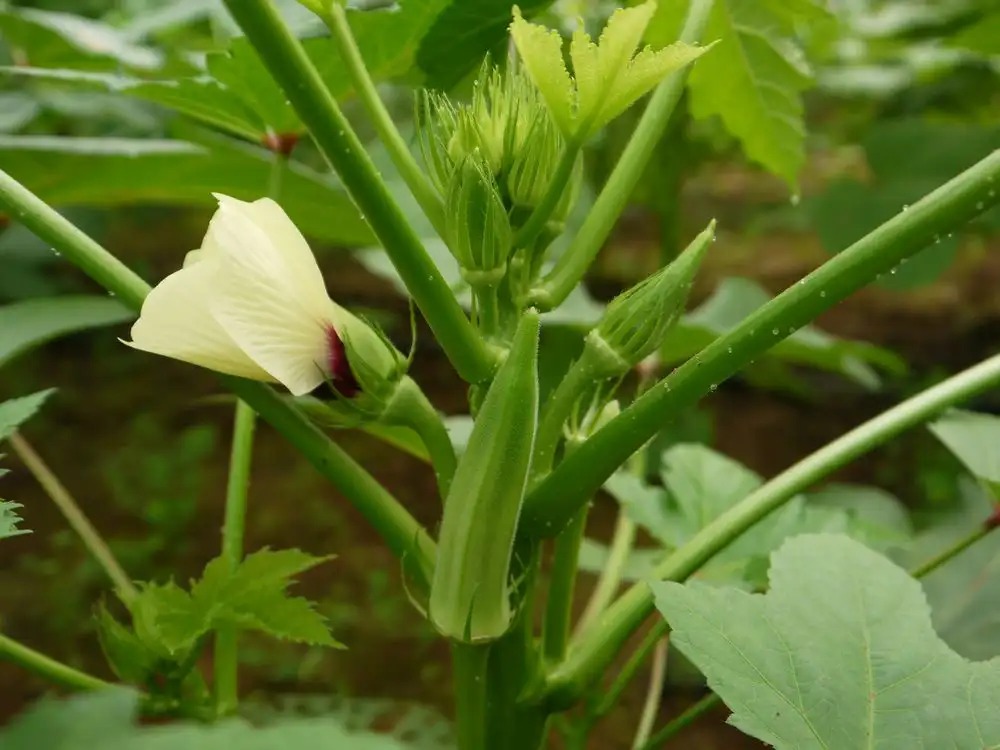
Appendix: Related information about okra
The number of patients with diabetes seems to be increasing. In addition to traditional Chinese and Western medicine medications, dietary therapy should be considered to alleviate the condition and prevent its progression. Commonly recommended dietary therapies include Chinese yam and okra. Here's some information on okra for your reference:
Okra (scientific name: Abelmoschusesculentus) is also known as six-cornered beans, okra, hollyhock, and lady's finger beans.
1. The main functions of okra:
1. Protect gastric mucus
In addition to containing rich nutrients, its mucus can adhere to the gastric mucosa and protect the stomach wall, which is commonly known as "taking care of the stomach."
2. Prevent colorectal cancer
The sticky juice of okra contains water-soluble fibers such as pectin, galactan, and gum arabic. These three ingredients are all water-soluble dietary fibers. In addition to lowering blood pressure and aiding digestion, they are also helpful in preventing colorectal cancer.
3. It contains more calcium and is easier to absorb than milk
For example, 100 grams of okra contains 80 to 100 mg of calcium, comparable to an equal weight of fresh milk. However, okra's calcium absorption rate is 50 to 60%, which is better than milk. This makes it an excellent source of calcium for vegetarians, growing children, and those who experience diarrhea after drinking milk.
2. Notes:
1. It has a cold nature. People with weak spleen and stomach, prone to diarrhea or loose stools should not eat too much.
Okra is a cold food, so people with yin deficiency should not eat it in excess; for those with poor gastrointestinal function, overeating may cause diarrhea.
Okra is very susceptible to scratches and will quickly turn black after being scratched. When picking or storing, pick it up individually and do not squeeze it. It is best to put it in a fresh-keeping bag before putting it in the refrigerator and try to let it lie flat.
3. The effect of okra on diabetes
Taking okra can relieve the symptoms of diabetes and control blood sugar
Instructions: Take two kiwi beans and cut off the ends. Then make a small cut along the middle of the long stem. Place the two kiwi beans in a cup of water (at room temperature), cover, and let it sit overnight at room temperature. In the morning, before breakfast, remove the two kiwi beans from the water, discard the two beans, and drink the water. Another method is to chop the two kiwi beans each evening, add about a bowl of boiling water, and drink the whole thing the next morning. Do this daily for two weeks, and you'll see a noticeable blood sugar lowering effect. Diabetics may want to try this.
If taking okra causes diarrhea, you can try yam instead. If your blood sugar is high, you need to take both Chinese and Western medicine to achieve stable results.